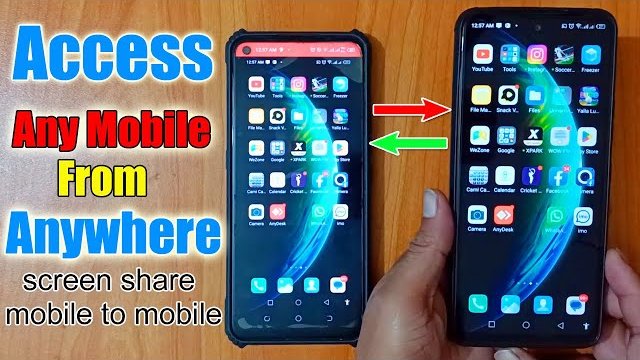Introduction
AnyDesk Mobile Remote Access Remote access technology has become a cornerstone in today’s interconnected world, providing users with the ability to control devices and access data from virtually anywhere. Among the myriad of remote access tools available, AnyDesk stands out due to its speed, simplicity, and robust features. This essay delves into the intricacies of AnyDesk, exploring its development, functionalities, applications, and impact on various sectors.

The Evolution of Remote Access Technology
The concept of remote access is not new. It dates back to the early days of computing when remote terminals were connected to central mainframes. With the advent of personal computers and the internet, remote access tools evolved to support a wide range of use cases, from technical support to telecommuting. Early pioneers like Telnet and Remote Desktop Protocol (RDP) laid the groundwork for modern solutions like AnyDesk.
Overview of AnyDesk
AnyDesk was founded in 2014 by ex-TeamViewer employees who sought to create a more efficient and user-friendly remote access tool. The primary focus was to overcome the limitations of existing solutions, particularly in terms of speed and latency. By developing a proprietary video codec called DeskRT, AnyDesk achieved unprecedented levels of performance, enabling smooth and responsive remote sessions even over low-bandwidth connections.

Key Features of AnyDesk
- High Performance: AnyDesk’s DeskRT codec compresses and transfers image data efficiently, ensuring minimal lag and high frame rates. This makes it suitable for tasks that require real-time interaction, such as graphic design or video editing.
- Cross-Platform Compatibility: AnyDesk supports a wide range of operating systems including Windows, macOS, Linux, Android, and iOS. This versatility allows users to access devices across different platforms seamlessly.
- Security: Security is a paramount concern for remote access solutions. AnyDesk employs TLS 1.2 encryption, the same standard used in online banking, to protect data transmitted during sessions. Additionally, the app features robust access control mechanisms to prevent unauthorized access.
- Ease of Use: The user interface of AnyDesk is designed for simplicity. Users can connect to a remote device by entering a unique ID, without needing complex setup procedures. Features like unattended access further streamline the user experience.
- Customization: AnyDesk offers customization options for businesses, including branding, session logging, and configurable security settings. This makes it a flexible solution for a variety of professional environments.
Applications of AnyDesk
- Remote Work: The COVID-19 pandemic accelerated the adoption of remote work, making tools like AnyDesk indispensable. It enables employees to access office computers from home, ensuring business continuity and productivity.
- Technical Support: IT support teams use AnyDesk to troubleshoot and resolve issues on remote devices. This reduces the need for on-site visits, saving time and resources.
- Collaboration: AnyDesk facilitates collaboration by allowing multiple users to view and control a single device. This is particularly useful in educational settings, where teachers can demonstrate software usage or assist students remotely.
- Managed Service Providers (MSPs): MSPs leverage AnyDesk to manage and maintain clients’ IT infrastructure. Features like session recording and audit logs help in compliance and quality assurance.
- Healthcare: Telemedicine has gained traction as a means to provide healthcare services remotely. AnyDesk can be used to access medical records and diagnostic tools, enabling healthcare professionals to deliver care without physical proximity.

Technical Architecture
AnyDesk Mobile Remote Access AnyDesk’s performance and reliability are underpinned by its technical architecture. The core component, DeskRT, is a video codec optimized for graphical user interfaces. Unlike traditional codecs designed for video playback, DeskRT focuses on low latency and high compression efficiency, making it ideal for interactive applications.
AnyDesk also employs a robust network infrastructure to ensure connectivity and redundancy. The app automatically selects the best server for a given connection, balancing load and minimizing latency. Furthermore, AnyDesk’s peer-to-peer technology can establish direct connections between devices, bypassing server relays when possible to enhance performance.
Security Considerations
In the realm of remote access, security is a critical concern. AnyDesk addresses this with a multi-layered approach:
- Encryption: All data transmitted between devices is encrypted using TLS 1.2, preventing eavesdropping and data breaches.
- Access Control: Users can configure permissions for each session, specifying who can view or control their device. This prevents unauthorized access and ensures user control over their data.
- Session Logging: For compliance and audit purposes, AnyDesk can log session details, including time stamps and participant information. This is particularly useful for businesses that need to adhere to regulatory standards.
- Two-Factor Authentication (2FA): To enhance security, AnyDesk supports 2FA, adding an extra layer of protection for user accounts.
Market Position and Competitors
AnyDesk Mobile Remote Access AnyDesk operates in a competitive market, facing rivals like TeamViewer, LogMeIn, and Microsoft Remote Desktop. Despite this, it has carved out a significant niche due to its performance advantages and user-centric design. According to various market analyses, AnyDesk’s user base has been growing rapidly, driven by its appeal to both individual users and enterprises.

User Feedback and Community
The success of AnyDesk can also be attributed to its active user community and responsive development team. User feedback is integral to AnyDesk’s development process, influencing new features and improvements. Online forums and social media platforms are replete with positive testimonials, highlighting the app’s ease of use and reliability.
Future Prospects
Looking ahead, AnyDesk is poised to continue its growth trajectory. The ongoing shift towards remote work and digital transformation across industries will drive demand for robust remote access solutions. AnyDesk’s commitment to innovation, particularly in enhancing performance and security, positions it well to capitalize on these trends.
Potential future developments may include enhanced support for emerging technologies like virtual reality (VR) and augmented reality (AR), further expanding the use cases for remote access. Additionally, as cybersecurity threats evolve, AnyDesk will likely continue to bolster its security measures to protect users’ data.

Conclusion
AnyDesk has established itself as a leading player in the remote access market through a combination of technical excellence, user-friendly design, and robust security features. Its innovative approach, epitomized by the DeskRT codec, sets it apart from competitors and meets the diverse needs of modern users. As remote work and digital collaboration become increasingly prevalent, AnyDesk is well-equipped to play a pivotal role in shaping the future of remote access technology.
App Link
In conclusion, AnyDesk exemplifies how cutting-edge technology can transform traditional practices, enabling seamless and secure remote interactions. Its impact on various sectors underscores the importance of reliable remote access solutions in today’s digital age.

